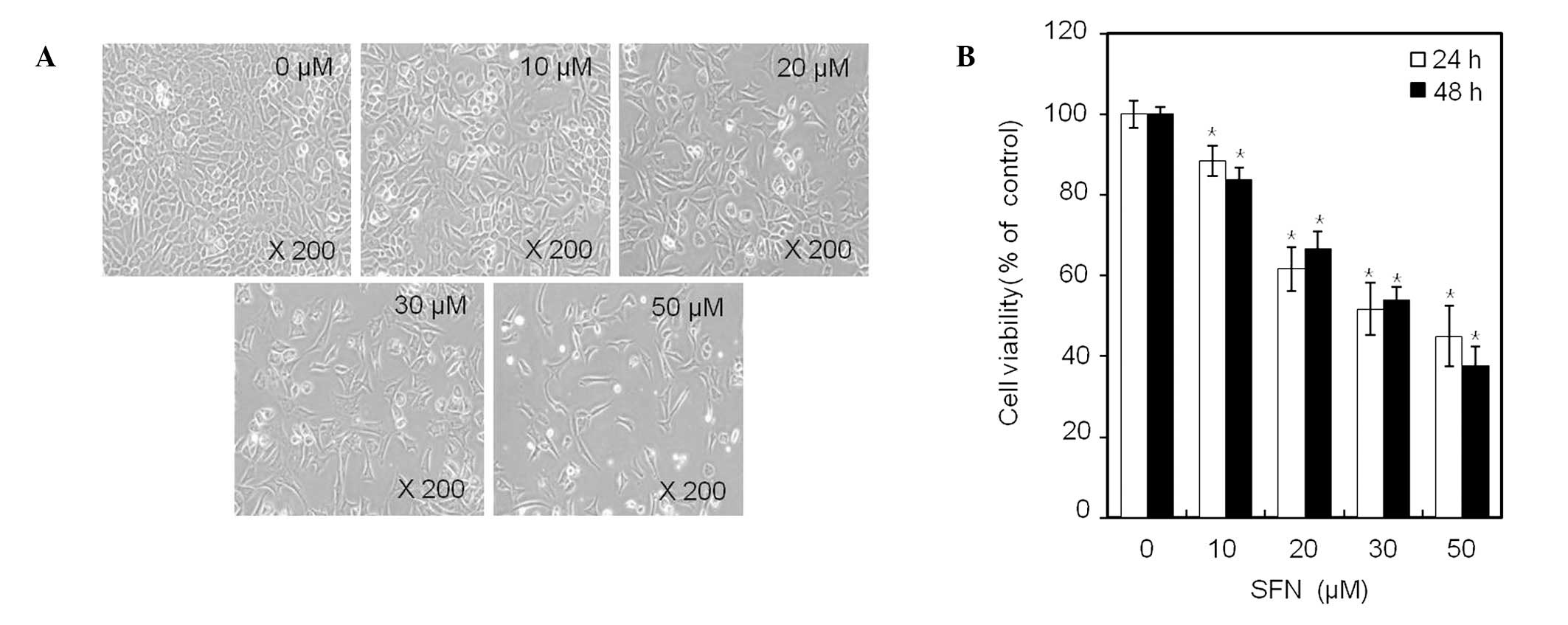|
1
|
Loeser RF, Chubinskaya S, Pacione C and Im
HJ: Basic fibroblast growth factor inhibits the anabolic activity
of insulin-like growth factor 1 and osteogenic protein 1 in adult
human articular chondrocytes. Arthritis Rheum. 52:3910–3917. 2005.
View Article : Google Scholar
|
|
2
|
Pulai JI, Del Carlo M Jr and Loeser RF:
The alpha5beta1 integrin provides matrix survival signals for
normal and osteoarthritic human articular chondrocytes in vitro.
Arthritis Rheum. 46:1528–1535. 2002. View Article : Google Scholar : PubMed/NCBI
|
|
3
|
Gamet-Payrastre L, Lumeau S, Gasc N,
Cassar G, Rollin P and Tulliez J: Selective cytostatic and
cytotoxic effects of glucosinolates hydrolysis products on human
colon cancer cells in vitro. Anticancer Drugs. 9:141–148. 1998.
View Article : Google Scholar : PubMed/NCBI
|
|
4
|
Jackson SJ and Singletary KW:
Sulforaphane: a naturally occurring mammary carcinoma mitotic
inhibitor, which disrupts tubulin polymerization. Carcinogenesis.
25:219–227. 2004. View Article : Google Scholar
|
|
5
|
Parnaud G, Li P, Cassar G, et al:
Mechanism of sulforaphane-induced cell cycle arrest and apoptosis
in human colon cancer cells. Nutr Cancer. 48:198–206. 2004.
View Article : Google Scholar : PubMed/NCBI
|
|
6
|
Chung FL, Conaway CC, Rao CV and Reddy BS:
Chemoprevention of colonic aberrant crypt foci in Fischer rats by
sulforaphane and phenethyl isothiocyanate. Carcinogenesis.
21:2287–2291. 2000. View Article : Google Scholar : PubMed/NCBI
|
|
7
|
Kassie F, Uhl M, Rabot S, et al:
Chemoprevention of 2-amino-3-methylimidazo[4,5-f]quinoline
(IQ)-induced colonic and hepatic preneoplastic lesions in the F344
rat by cruciferous vegetables administered simultaneously with the
carcinogen. Carcinogenesis. 24:255–261. 2003.
|
|
8
|
Fahey JW, Haristoy X, Dolan PM, et al:
Sulforaphane inhibits extracellular, intracellular, and
antibiotic-resistant strains of Helicobacter pylori and
prevents benzo[a]pyrene-induced stomach tumors. Proc Natl Acad Sci
USA. 99:7610–7615. 2002. View Article : Google Scholar : PubMed/NCBI
|
|
9
|
Gamet-Payrastre L, Li P, Lumeau S, et al:
Sulforaphane, a naturally occurring isothiocyanate, induces cell
cycle arrest and apoptosis in HT29 human colon cancer cells. Cancer
Res. 60:1426–1433. 2000.PubMed/NCBI
|
|
10
|
Zhang C, Zhu H, Yang X, et al: P53 and p38
MAPK pathways are involved in MONCPT-induced cell cycle G2/M arrest
in human non-small cell lung cancer A549. J Cancer Res Clin Oncol.
136:437–445. 2010. View Article : Google Scholar : PubMed/NCBI
|
|
11
|
Chen AC and Donovan SM: Genistein at a
concentration present in soy infant formula inhibits Caco-2BBe cell
proliferation by causing G2/M cell cycle arrest. J Nutr.
134:1303–1308. 2004.PubMed/NCBI
|
|
12
|
Schwartz GK and Shah MA: Targeting the
cell cycle: a new approach to cancer therapy. J Clin Oncol.
23:9408–9421. 2005. View Article : Google Scholar : PubMed/NCBI
|
|
13
|
Xiong Y, Hannon GJ, Zhang H, Casso D,
Kobayashi R and Beach D: p21 is a universal inhibitor of cyclin
kinases. Nature. 366:701–704. 1993. View
Article : Google Scholar : PubMed/NCBI
|
|
14
|
Kim JH, Han Kwon K, Jung JY, et al:
Sulforaphane increases cyclin-dependent kinase inhibitor, p21
protein in human oral carcinoma cells and nude mouse animal model
to induce G(2)/M cell cycle arrest. J Clin Biochem Nutr. 46:60–67.
2010.PubMed/NCBI
|
|
15
|
Chiao JW, Chung FL, Kancherla R, Ahmed T,
Mittelman A and Conaway CC: Sulforaphane and its metabolite mediate
growth arrest and apoptosis in human prostate cancer cells. Int J
Oncol. 20:631–636. 2002.PubMed/NCBI
|
|
16
|
Fimognari C, Nüsse M, Cesari R, Iori R,
Cantelli-Forti G and Hrelia P: Growth inhibition, cell-cycle arrest
and apoptosis in human T-cell leukemia by the isothiocyanate
sulforaphane. Carcinogenesis. 23:581–586. 2002. View Article : Google Scholar : PubMed/NCBI
|
|
17
|
Herman-Antosiewicz A, Xiao H, Lew KL and
Singh SV: Induction of p21 protein protects against
sulforaphane-induced mitotic arrest in LNCaP human prostate cancer
cell line. Mol Cancer Ther. 6:1673–1681. 2007. View Article : Google Scholar : PubMed/NCBI
|
|
18
|
Blethrow JD, Glavy JS, Morgan DO and
Shokat KM: Covalent capture of kinase-specific phosphopeptides
reveals Cdk1-cyclin B substrates. Proc Natl Acad Sci USA.
105:1442–1447. 2008. View Article : Google Scholar : PubMed/NCBI
|
|
19
|
Chu WF, Wu DM, Liu W, et al: Sulforaphane
induces G2-M arrest and apoptosis in high metastasis cell line of
salivary gland adenoid cystic carcinoma. Oral Oncol. 45:998–1004.
2009. View Article : Google Scholar : PubMed/NCBI
|
|
20
|
Ho JW, Song JZ and Leung YK: Activation of
p53 by specific agents in potential cancer therapy. Curr Med Chem
Anticancer Agents. 5:131–135. 2005. View Article : Google Scholar : PubMed/NCBI
|
|
21
|
Michalovitz D, Halevy O and Oren M:
Conditional inhibition of transformation and of cell proliferation
by a temperature-sensitive mutant of p53. Cell. 62:671–680. 1990.
View Article : Google Scholar : PubMed/NCBI
|
|
22
|
Stewart N, Hicks GG, Paraskevas F and
Mowat M: Evidence for a second cell cycle block at G2/M by p53.
Oncogene. 10:109–115. 1995.PubMed/NCBI
|
|
23
|
Vikhanskaya F, Erba E, D’Incalci M and
Broggini M: Introduction of wild-type p53 in a human ovarian cancer
cell line not expressing endogenous p53. Nucleic Acids Res.
22:1012–1017. 1994. View Article : Google Scholar : PubMed/NCBI
|
|
24
|
Charrier-Savournin FB, Château MT, Gire V,
Sedivy J, Piette J and Dulic V: p21-Mediated nuclear retention of
cyclin B1-Cdk1 in response to genotoxic stress. Mol Biol Cell.
15:3965–3976. 2004. View Article : Google Scholar : PubMed/NCBI
|
|
25
|
Su C, Deaton RA, Iglewsky MA, Valencia TG
and Grant SR: PKN activation via transforming growth factor-beta 1
(TGF-beta 1) receptor signaling delays G2/M phase transition in
vascular smooth muscle cells. Cell Cycle. 6:739–749. 2007.
View Article : Google Scholar : PubMed/NCBI
|















